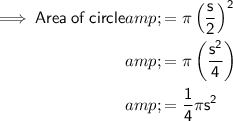Answer:

Explanation:
The width of a square is its side length.
The width of a circle is its diameter.
Therefore, the largest possible circle that can be cut out from a square is a circle whose diameter is equal in length to the side length of the square.
Formulas



If the diameter is equal to the side length of the square, then:

Therefore:

So the ratio of the area of the circle to the original square is:

Given:
- side length (s) = 6 in
- radius (r) = 6 ÷ 2 = 3 in


Ratio of circle to square:
